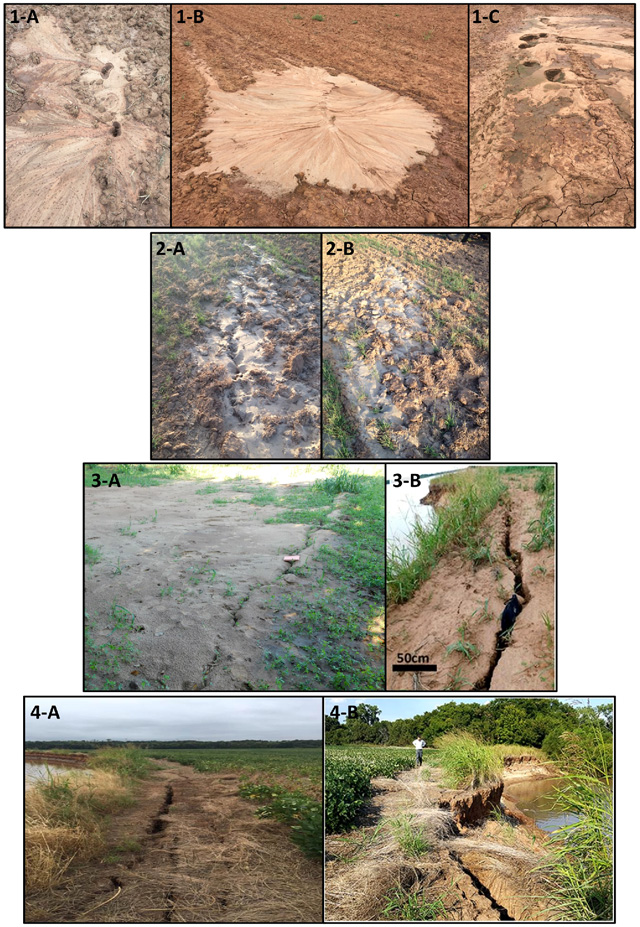23 October 2025—The 2016 magnitude 5.8 Pawnee earthquake in Oklahoma, caused by wastewater injection, is the first induced seismic event documented to cause liquefaction. Sand boils and surface cracks were observed at sites affected by the event’s strong ground shaking.
Geotechnical earthquake engineers have models to predict where and how severe these kinds of liquefaction manifestations occur during an earthquake, but those models were developed for earthquakes in seismically active places like California and New Zealand—natural tectonic events in shallow crust. Do the same models work as well for induced earthquakes in the middle of the continent?
In two recent papers published in Seismological Research Letters, researchers introduce and test a new liquefaction triggering model developed for induced earthquakes in Oklahoma, Texas, and Kansas.
Existing tectonic triggering models over-predict the liquefaction potential of induced earthquakes in Oklahoma, Texas, and Kansas, compared to the newly developed model by Russell Green of Virginia Tech and colleagues.
When the research team tested their new model against ground data from the 2016 Pawnee earthquake, they found that the new model more accurately predicted liquefaction manifestation severity at most sites compared to the tectonic models.
If tectonic-based models continue to be used to assess the liquefaction potential of induced earthquakes in this region, states could end spending money “unnecessarily” to reduce the risk of liquefaction at certain sites, the team concluded.
“It is important to note, however, that while the findings of this study show that the liquefaction potential from induced earthquakes is less than from tectonic earthquakes, the overall risk of liquefaction in areas currently experiencing liquefaction may still be higher than historic levels due to the increased rate of induced seismicity in these areas,” they cautioned.

The researchers began looking at whether liquefaction triggering models developed from tectonic events could be applied to induced earthquakes using data from the Groningen gas field in the Netherlands.
Although none of the induced Groningen earthquakes had triggered liquefaction, “a lot of excellent work had already been done in developing ground motion models for these induced events,” Green explained. “The development of the new ground motion models was motivated by the uniqueness of the seismic sources and the geologic profiles, and because low magnitude events were driving the seismic hazard.”
As new ground motion models were developed for induced earthquakes in the central United States, he added, “this in turn provided the motivation for developing the new liquefaction triggering relationship for induced earthquakes in Oklahoma, Texas, and Kansas.”
For these states, Green and colleagues developed an induced seismicity-based liquefaction model that includes parameters based on how regional soils respond to earthquake shaking that is characteristic of induced ground shaking in the region.
“It wasn’t surprising that the tectonic model produced different results than the induced model we developed,” Green said. “We actually expected this based on the difference in the induced versus tectonic ground motions and the unique geologic profiles in Oklahoma, Texas, and Kansas.”
But “in the Netherlands we found that the tectonic model underpredicted the liquefaction hazard compared to the Groningen-specific model,” he added. “So, it was a little surprising that the opposite trend was observed for Oklahoma, Texas, and Kansas.”
“I don’t know whether the differences in the ground motion characteristics or the differences in the geologic profiles are more influential to liquefaction triggering,” Green noted. “We are looking into this exact question for another regional liquefaction triggering model we currently developing.”
Green said he and his collaborators are almost finished with a new liquefaction triggering model for megathrust subduction zone events in the U.S. Pacific Northwest, while also working on other regionally applicable liquefaction models.
The two papers were included in SRL’s November 2025 Special Focus section on earthquake-induced ground deformation.
